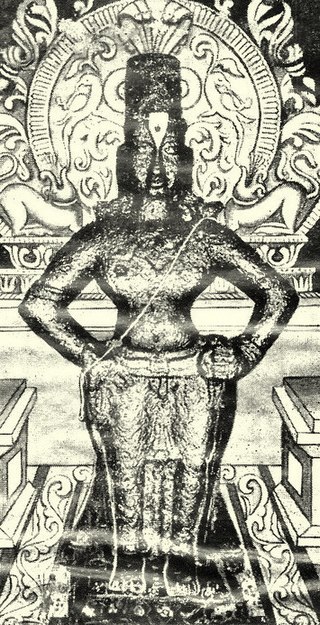
Vithoba, also known as Vi(t)thal(a) and Panduranga, is a Hindu deity predominantly worshipped in the Indian state of Maharashtra and Karnataka. He is generally considered as a manifestation of the god Vishnu, or his avatar Krishna. Vithoba is often depicted as a dark young boy, standing arms akimbo on a brick, sometimes accompanied by his consort Rakhumai.

Lingaraja Temple is a Hindu temple dedicated to Shiva and is one of the oldest temples in Bhubaneswar, the capital of the Indian state of Odisha, India. The temple is the most prominent landmark of Bhubaneswar city and one of the major tourist attractions of the state.
Tourism in Odisha is one of the main contributors to the Economy of Odisha, India, with a 500 km (310 mi) long coastline, mountains, lakes, natural biodiversity and rivers. Odisha is one of the major tourism sectors of India, with various tourists' attractions, ranging from wildlife reserves, beaches, temples, monuments, the arts and festivals. Other than wildlife reserves, beaches, temples, monuments, the arts and festivals, the Odisha Tourism Development Corporation, a Public Sector Undertaking of Government of Odisha, is also developing tourism sector of Odisha and India.

Baitāḷa deuḷa or Vaitāḷa deuḷa is an 8th-century Hindu temple of the typical Khakara style of the Kalinga architecture dedicated to Goddess Chamunda located in Bhubaneswar, the capital city of Odisha, India. It is also locally known as Tini-mundia deula due to the three spires on top of it, a very distinct and unusual feature. The three spires are believed to represent the three powers of the goddess Chamunda - Mahasaraswati, Mahalakshmi and Mahakali.
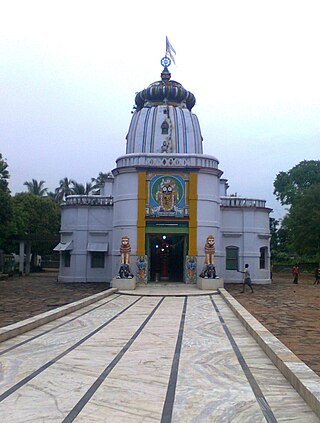
Jagannath temple at Nayagarh, Odisha, India, was erected by Vinayak Singh Mandhata in between 1788 and 1808 AD. It is unfinished, the architect of this temple was the father of the poet Yadumani. Jagannath temple at Laxmi Prasad area was erected by Jadunath Mangaraja, a king of Khandapada. It was reconstructed in 1972 by one Sri Nilakantha Sahu. Jagannath temple at Khandapada was erected by the king of Khandapada. The temple is in pancharatha Rekha Deula style, while the Jaga mohan and Natamandapa are in Pidha Deula style. The idol of Jagannath called DadhiVanana was brought from the temple at Tikiripada and installed here. The idols from this temple were installed there. Jagannath temple at Tikiripada was constructed with the stones of the tomb of Gosinha Daitya, a demon ruling in this area in the past, whose fort is located inside Baisipalli, also known as Gosinhagarh during the epic period. The first temple was constructed in 1850. It was due to the flood of the Mahanadi in that year. The Jagannath temple at Ranpur was erected by King Udhaba Singh in 1324-1363 AD. The Jagannath temple at Daspalla is also an old one and Rajapratisthita. Jagannath temple at Sikharpur (Saranakul) is a unique one where bread (Roti) is offered to the Lord, his queen built the Mukhashala. Main festival here is Rath Yatra and Snana Yatra.
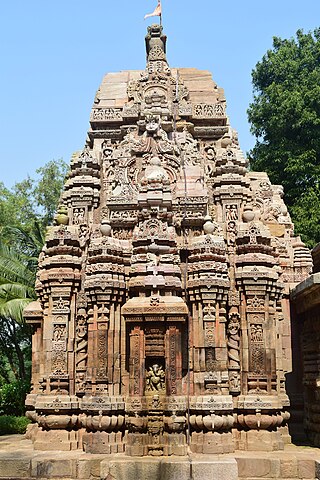
Barahi Deula is an ancient 9th century built temple situated on the eastern coast of Odisha in Puri district, India. The barahi temple of Chaurasi is unique in more than one way. The image enshrined in this temple is considered to be one of the masterpieces among the images of the deity found all over India.

Madhava Temple,, is the temple dedicated to Lord Vishnu. It is located at the Madhab village of Niali block in Cuttack district, Odisha.
The Harihara Deula or Twin Temples are dedicated to Lord Shiva and Lord Vishnu. They are situated near the bank of Mahanadi river, at Gandharadi village in Boudh district of Odisha, India.

Indralatha Temple is dedicated to Shiva and is situated in Bangomunda block near Ranipur-Jharial in Balangir district. It was supposed that Indra first worshipped lord Shiva here and erected a temple.

Joranda Gadhi is a temple built in a location where three villages meet: Joranda, Natima and Patna. The temple is dedicated to the supreme lord. The followers of mahima dharma worship him as Sunya Brahma or the shapeless lord. No idol worship is permitted in this sect. The temple is dedicated to the supreme lord. Many people of other sects believe that the followers of this sect worship Surya, the sun god, but it is absolutely false. They just pray to the supreme lord facing to the direction of surya because it fixes the direction of concentration. One can choose one's own fix direction apart from east and west, but once fixed it cannot be changed.

The Chateswar Temple is a Hindu temple of Odisha, India, which is dedicated to Lord Mahadev.It is one of a patalaphuta Shivalinga Temple and it is located at the Kishinapur village of Salipur in Cuttack district.

The Durga Temple is a Hindu temple dedicated to Goddess Durga and located in Baideshwar village on the way to Banki of Cuttack District in Odisha, India.
The Brahma Temple is a Hindu temple of creator God Brahma is located at the north-eastern side of the Niali village in Cuttack district of Odisha, India. It is very near to Madhava Temple, Niali. Some local Brahmins opine that an Ashwamedha yajna was done by Brahma here.

Annakoteshwara Temple, Annakoteswar Temple, or Annakotisvara Siva Temple is located in Latadeipur in Gondia tehsil in Dhenkanal district, Odisha, India. The Temple is dedicated to Lord Shiva with a stone shivalinga.
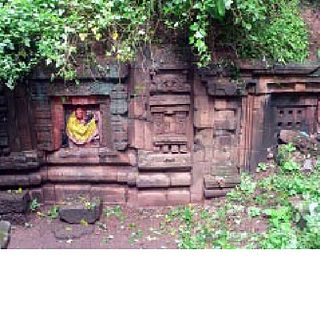
Narayani Temple is dedicated to ten armed goddess Narayani or Parvathi and is located in Narayani village situated near Khalikote, Odisha, India. The temple is popular for Durga Puja and a fair held in the Indian month of Chaitra. The temple was renovated by the zamindars of Khalikote in the early 18th century. The style of the temple is a Khakhara Deula, like Vaital Deula. It is supposed to have existed before 12th Century AD. The temple is known for the scenic beauty of the surrounding countryside' including Chilika Lake.

The Kaḷinga architectural style is a style of Hindu architecture which flourished in the ancient Kalinga previously known as Utkal and in present eastern Indian state of Odisha. The style consists of three distinct types of temples: Rekha Deula, Pidha Deula and Khakhara Deula. The former two are associated with Vishnu, Surya and Shiva temples while the third is mainly with Chamunda and Durga temples. The Rekha Deula and Khakhara Deula houses are the sanctum sanctorum while the Pidha Deula constitutes outer dancing and offering halls.
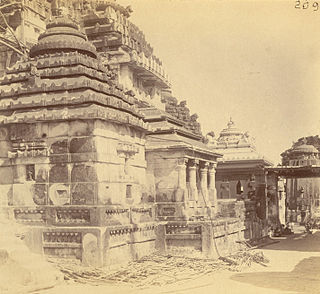
The Vimala Temple or Bimala Temple is a Hindu temple dedicated to goddess Vimala or Bimala (ବିମଳା), located within the Jagannath Temple complex in Puri in the Indian state of Odisha. It is generally regarded as a Shakti Pitha, among the holiest temples dedicated to the Hindu Goddess.

The Varahanatha Temple, also known as Yajna Varaha Temple, is a Hindu temple complex, located on the left bank of the Vaitarani River on an island formed by the river, in Jajpur, Odisha, India. The main shrine is dedicated to Varaha, the boar avatar of the god Vishnu. Built in 15-16th century, the temple is constructed in Kalinga architectural style. Besides the central Varaha shrine, there are numerous subordinate shrines to deities like Shiva, Vishnu, Vimala and others.
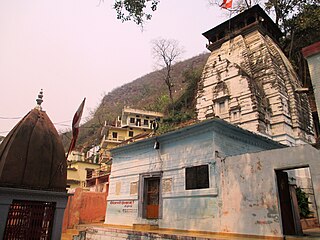
Raghunathji Temple in Devprayag, a pilgrimage town in Tehri Garhwal district in Himalayas in the North Indian state of Uttarakhand, is dedicated to Vishnu. It is located 73 km from Rishikesh on the Rishikesh–Badrinath highway. Constructed in the Deula style, the temple is glorified in the Nalayira Divya Prabandham, the early medieval Tamil canon of the Alvar saints from the 6th–9th centuries CE. It is one of the 108 Divyadesam dedicated to Vishnu, who is worshipped as Raghunathji (Rama) and his consort Lakshmi as Sita.















